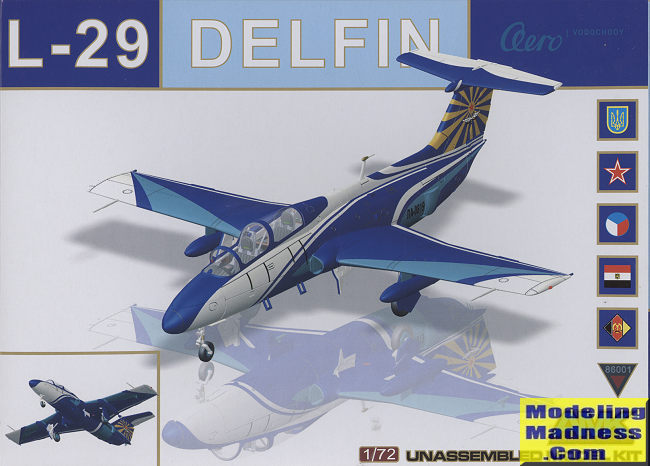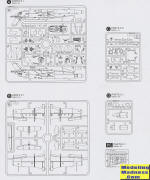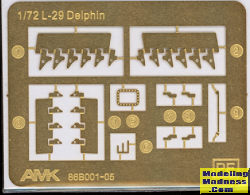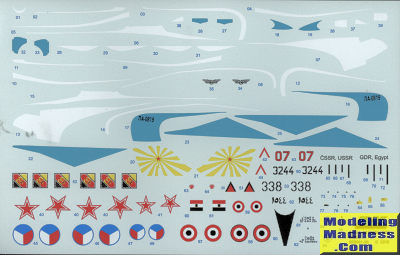
AMK 1/72 L.29 Delfin
| KIT #: | 86001 |
| PRICE: | $16.99 shipped |
| DECALS: | Five options |
| REVIEWER: | Scott Van Aken |
| NOTES: | 2018 tooling |

| HISTORY |
The Aero L-29 Delfín (English: Dolphin, NATO reporting name: Maya) is a military jet trainer aircraft that became the standard jet trainer for the air forces of Warsaw Pact nations in the 1960s. It was Czechoslovakia's first locally designed and built jet aircraft.
In the late 1950s, the Soviet Air Force was seeking a jet-powered replacement for its fleet of piston-engined trainers, and this requirement was soon broadened to finding a trainer aircraft that could be adopted in common by Eastern Bloc air forces. Aero's response, the prototype XL-29 designed by Z. Rublič and K. Tomá first flew on 5 April 1959, powered by a British Bristol Siddeley Viper engine. The second prototype was powered by the Czech-designed M701 engine, which was used in all subsequent aircraft.
The basic design concept was to produce a straightforward, easy-to-build and operate aircraft. Simplicity and ruggedness were stressed with manual flight controls, large flaps and the incorporation of perforated airbrakes on the fuselage sides providing stable and docile flight characteristics, leading to an enviable safety record for the type. The sturdy L-29 was able to operate from grass, sand or unprepared fields. Both student pilot and instructor had ejection seats, and were positioned in tandem, under separate canopies with a slightly raised instructor position.
In 1961, the L-29 was evaluated against the PZL TS-11 Iskra and Yakovlev Yak-30 and emerged the winner. Poland chose to pursue the development of the TS-11 Iskra anyway, but all other Warsaw Pact countries adopted the Delfin under the agreements of COMECON.
Production began April 1963 and continued for 11 years, with 3,600 eventually built until 1974. A dedicated, single-seat, aerobatic version was developed as the L-29A Akrobat. A reconnaissance version with nose-mounted cameras was built as the L-29R.
The L-29 was operated by literally dozens of air forces and is still equipping a handful. A considerable number are being operated as warbirds.
| THE KIT |
 A
few years back I built the 1/48 version of this kit and was fairly pleased with
how it turned out. This is, as you might expect, a reduced down and simplified
version of that kit. This kit does use photo etch brass, but not to the same
extent. For instance, there is etched flap detail, but it is all on one piece
rather than a half dozen or s
A
few years back I built the 1/48 version of this kit and was fairly pleased with
how it turned out. This is, as you might expect, a reduced down and simplified
version of that kit. This kit does use photo etch brass, but not to the same
extent. For instance, there is etched flap detail, but it is all on one piece
rather than a half dozen or s o
separate bits per side. Unfortunately, the p.e. does not extend to a seat
harness. It does include an antenna, a panel line and the hinges for the speed
brakes.
o
separate bits per side. Unfortunately, the p.e. does not extend to a seat
harness. It does include an antenna, a panel line and the hinges for the speed
brakes.
Each of the cockpit seats is five pieces and fits ino a single piece tub. The instrument panels, control sticks, bulkheads and seat rails are then added. One could hold off installing the seats until just before attaching the canopy if one wishes. The forward bulkhead is where the nose gear well and upper nose compartment attach. These have hydraulic or pneumatic bottles to be attached. Once this and the tailpipe are assembled, the interior can be installed into the fuselage and that closed. No indication of any weight is given, but I'd be surprised if it wasn't tail heavy. You'll need to find room as there isn't a ton of space for it.
The wing flaps can be posed down and to do this one needs to bend and install the hinge detail p.e. pieces. Conversely, you can cut off the mounting tabs from the flaps and model them in the up position. Before closing the wing halves you need to install the intake trunking, such as it is. The horizontal stab has separate elevators. Many photos of this plane show it parked with these in the up position. There is also a separate rudder.
The landing gear is well done and looks properly complex. Installing the nose gear with be a bit tricky as part of it fits far into the forward bulkhead. Some of the gear doors are normally closed, but you need to have the gear installed to properly attach these. Speed brakes can be posed open or closed. The hinges for these are photo etch and quite small. You can also pose the canopies open. There are fuel tanks for under the wings. Finally, the nose compartment can be posed open or closed. You are give two separate panels for this. Most of us will probably not install the bottles there and use this small space for weight, using the closed panel option.
 Instructions
are well done and provide color information using what appears to be Humbrol
paints. The instruction sheet itself reminds me of a road map. The large sheet
is folded in half and then folded twice again. Not sure I like this, but using
it will tell. There are markings for five aircraft. The Czech and Russian planes
are in 'silver' which is probably unpainted metal. The Egyptian offering is in
sand/green/brown over red, while the East German plane is green/brown over light
blue. Finally, the box art plane from Ukraine in an aero club scheme. For this
one you basically paint the plane dark blue and apply all the other shades save
the white elevators as decals. The AMK decals I used with the 1/48 plane were
very good and I expect these to be the same.
Instructions
are well done and provide color information using what appears to be Humbrol
paints. The instruction sheet itself reminds me of a road map. The large sheet
is folded in half and then folded twice again. Not sure I like this, but using
it will tell. There are markings for five aircraft. The Czech and Russian planes
are in 'silver' which is probably unpainted metal. The Egyptian offering is in
sand/green/brown over red, while the East German plane is green/brown over light
blue. Finally, the box art plane from Ukraine in an aero club scheme. For this
one you basically paint the plane dark blue and apply all the other shades save
the white elevators as decals. The AMK decals I used with the 1/48 plane were
very good and I expect these to be the same.
| CONCLUSIONS |
If you are a fan of trainers or just like the L.29, then this is a kit for you. It is not expensive and has all the detail you would want (save seat harnesses).
July 2018
Copyright ModelingMadness.com. All rights reserved.
If you would like your product reviewed fairly and fairly quickly, please contact the editor or see other details in the Note to Contributors.